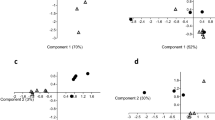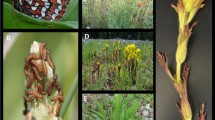Abstract
We examined the effects of a set of four biosynthetically related iridoid glycosides, aucubin, catalpol, loganin, and asperuloside, on larvae of a generalist,Lymantria dispar (Lymantriidae), the gypsy moth, and an adapted specialist, the buckeye,Junonia coenia (Nymphalidae). In general,L. dispar grew and survived significantly less well on artificial diets containing iridoid glycoside, compared to a control diet without iridoid glycosides. In choice tests, previous exposure to a diet containing iridoid glycosides caused larvae subsequently to prefer iridoid glycoside-containing diets even though they were detrimental to growth and survival. In contrast,J coenia larvae grew and survived better on diets with aucubin and catalpol, the two iridoid glycosides found in the host plantPlantago lanceolata (Plantaginaceae), than on diets with no iridoid glycoside or with loganin and asperuloside. The results of choice tests of diets with and without iridoid glycosides and between diets with different iridoid glycosides reflected these differences as well. These results are discussed in terms of (1) differences between generalists and specialists in their response to qualitative variation in plant allelochemical content, (2) the induction of feeding preferences, and (3) the evolution of qualitative allelochemical variation as a plant defense.
Similar content being viewed by others
References
Barbosa, P., Martinat, P., andWaldvogel, M. 1986. Development, fecundity and survival of the herbivoreLymantria dispar and the number of plant species in its diet.Ecol. Entomol. 11:1–6.
Bentley, M.D., Leonard, D.E., Reynolds, E.K., Leach, S., Beck, A.B., andMurakoshi, I. 1984a. Lupine alkaloids as larval feeding deterrents for spruce budworm,Choristoneura fumiferana (Lepidoptera: Tortricidae).Ann. Entomol. Soc. Am. 77:398–400.
Bentley, M.D., Leonard, D.E., andBushway, R.J. 1984b.Solanum alkaloids as larval feeding deterrents for spruce budworm,Choristoneura fumiferana (Lepidoptera: Tortricidae).Ann. Entomol. Soc. Am. 77:401–403.
Berenbaum, M. 1985. Brementown revisited: Interactions among allelochemicals in plants.Recent Adv. Phytochem. 19:139–169.
Berenbaum, M., Zangerl, A.R., andNitao, J.K. 1986. Constraints on chemical coevolution: wild parsnips and the parsnip webworm.Evolution 40:1215–1228.
Bernays, E.A., andDeluca, C. 1981. Insect anti-feedant properties of an iridoid glycoside: Ipolamiide.Experientia 37:1289–1290.
Blau, P.A., Feeny, P., Contardo, L., andRobson, D. 1978. Allylglucosinolate and herbivorous caterpillars: A contrast in toxicity and tolerance.Science 200:1296–1298.
Bobbitt, J.M., andSegebarth, K.P. 1969. Iridoid glycosides and similiar substances, pp. 1–145,in W.I. Taylor and A.R. Battersby (eds.). Cyclopentanoid Terpene Derivatives. Marcel Dekker, New York.
Bobbitt, J.M., Schmid, H., andAfrica, T.B. 1961.Catalpa glycosides. I. the characterization of catalposide.J. Org. Chem. 26:3090–3094.
Bowers, M.D. 1980. Unpalatability as a defense strategy ofEuphydryas phaeton (Lepidoptera: Nymphalidae).Evolution 34:367–375.
Bowers, M.D. 1981. Unpalatability as a defense strategy of western checkerspot butterflies (Euphydryas, Nymphalidae).Evolution 35:367–375.
Bowers, M.D. 1983. Iridoid glycosides and larval hostplant specificity in checkerspot butterflies (Euphydryas: Nymphalidae).J. Chem. Ecol. 9:475–493.
Bowers, M.D. 1984. Iridoid glycosides and host-plant specificity in larvae of the Buckeye butterfly,Junonia coenia (Nymphalidae).J. Chem. Ecol. 10:1567–1577.
Bowers, M.D., andPuttick, G.M. 1986. The fate of ingested iridoid glycosides in lepidopteran herbivores.J. Chem. Ecol. 12:169–178.
Brower, L.P. 1984. Chemical defense in butterflies, pp. 109–134,in R.I. Vane-Wright and P.R. Ackery (eds.). The Biology of Butterflies, Symposium of the Royal Entomological Society of London, 11. Academic Press, London.
Brower, L.P., Seiber, J.N., Nelson, C.J., Lynch, S.P., andTuskes, P.M. 1982. Plant-determined variation in the cardenolide content, thin-layer chromatography profiles, and emetic potency of monarch butterflies,Danaus plexippus, reared on the milkweed,Asclepias eriocarpa, in California.J. Chem. Ecol. 8:579–633.
Chambliss, O.L., andJones, C.M. 1966. Cucurbitacins: Specific insect attractants in Cucurbitaceae.Science 153:1392–1393.
Cohen, J. 1983. Chemical Interactions among Milkweed Plants (Asclepiadaceae) and Lepidopteran Herbivores. PhD thesis. University of Florida, Gainesville.
Cooper-Driver, G.A., Finch, S., Swain, T., andBernays, E. 1977. Seasonal variation in secondary plant compounds in relation to the palatability ofPteridium aquilinum.Biochem. Syst. Ecol. 5:211–218.
Dahlgren, R., Jensen, S.R., andNielsen, B.J. 1981. A revised classification of the Angiosperms with comments on the correlation between chemical and other characters, pp. 149–204,in D.A. Young andD.S. Seigler (eds.. Phytochemistry and Angiosperm Phylogeny. Praeger, New York.
Deboer, G., andHanson, F.E. 1984. Foodplant selection and induction of feeding preference among host and non-host plants in larvae of the tobacco hornwormManduca sexta.Entomol. Exp. Appl. 35:177–193.
Dolinger, P.M., Ehrlich, P.R., Fitch, W.L., andBreedlove, D.E. 1973. Alkaloid and predation patterns in Colorado lupine populations.Oecologia 13:191–204.
Ehrlich, P.R., andRaven, P.H. 1964. Butterflies and plants: A study in coevolution.Evolution 18:586–608.
El-Naggar, L.J., andBeal, J.L. 1980. Iridoids: A review.J. Nat. Prod. 3:649–707.
El-Naggar, S.F., andDoskotch, R.W. 1980. Specioside: A new iridoid glycoside fromCatalpa speciosa.J. Nat. Prod. 43:524–526.
Feeny, P. 1976. Plant apparency and chemical defense.Recent Adv. Phytochem. 10:1–40.
Gershenzon, J., andMabry, T.J. 1983. Secondary metabolites and the higher classification of angiosperms.Nord.J. Bot. 3:5–34.
Gibbs, R.D. 1974. Chemotaxonomy of Flowering Plants. McGill-Queens University Press, Montreal.
Gould, F. 1984. Mixed function oxidases: A devil's advocate position.Ecol. Entomol. 9:29–34.
Harris, G.H., Stermitz, F.R., andJing, W. 1986b. Iridoids and alkaloids fromCastilleja (Scrophulariaceae) hostplants forPlatyptilia pica (Lepidoptera: Pterophoridae): Rhexifoline content ofP. pica.Biochem. Syst. Ecol. 14:499–506.
Hegnauer, R. 1973. Chemotaxonomie der Pflanzen, Vol. 6. Berkauser Verlag, Basel.
Hegnauer, R., andKooiman, P. 1978. Die systematische Bedeutung von iridoiden Inhaltsstoffen im Rahmen von Wettstein's Tubiflorae.Planta Med. 33:1–33.
Inouye, H. 1971. Biosynthesis of iridoid and secoiridoid glucosides, pp. 290–313,in H. Wagner and L. Horhammer (eds.). Pharmacognosy and Phytochemistry. Springer, New York.
Jensen, S.R., Nielsen, B.J., andDahlgren, R. 1975. Iridoid compounds, their occurrence and systematic importance in the angiosperms.Bot. Not. 128:148–180.
Jermy, T., Hanson, F.E., andDethier, V.G. 1968. Induction of specific foodplant preferences in lepidopterous larvae.Entomol. Exp. Appl. 11:211–230.
Jirawongse, V. 1964. A Chemotaxonomic Study of the Scrophulariaceae. PhD thesis. Purdue University. University Microfilms, Ann Arbor Michigan.
Kaplan, M.A.C., andGottlieb, O.R. 1982. Iridoids as systematic markers in dicotyledons.Biochem. Syst. Ecol. 10:329–347.
Kooiman, P. 1970. The occurrence of iridoid glycosides in the Scrophulariaceae.Acta Bot. Neerl. 19:329–340.
Leonard, D.E. 1974. Recent developments in ecology and control of the gypsy moth.Annu. Rev. Entomol. 19:197–229.
Lincoln, D.E. andMooney, H.A. 1984. Herbivory onDiplcaus aurantiacus shrubs in sun and shade.Oecologia 4:173–178.
Lincoln, D.E., Newton, T.S., Ehrlich, P.R., andWilliams, K.S. 1982. Coevolution of the checkerspot butterflyEuphydryas chalcedona and its larval food plantDiplacus aurantiacus: Larval response to protein and leaf resin.Oecologia 52:216–223.
Louda, S.M., andRodman, I.E. 1983a. Ecological patterns in the glucosinolate content of a native mustard,Cardamine cordifolia in the Rocky Mountains.J. Chem. Ecol. 9:397–421.
Louda, S.M., andRodman, I.E. 1983b. Concentration of glucosinolates in relation to habitat and insect herbivory for the native cruciferCardamine cordifolia.Biochem. Syst. Ecol. 11:199–207.
McKey, D. 1979. The distribution of secondary compounds within plants, pp. 55–133,in G.A. Rosenthal andD.H. Janzen (eds.). Hervibores: Their Interaction with Secondary Plant Metabolites. Academic Press, New York.
McKey, D., Waterman, P.O., Mbi, C.N., Gartlan, G.N., andStruhsaker, T.T. 1978. Phenolic content of vegetation in two African rainforests: ecological implications.Science 202:61–64.
Metcalf, R.L., Metcalf, R.A., andRhodes, A.M. 1980. Cucurbitacins as kairomones for diabroticite beetles.Proc. Natl. Acad. Sci. U.S.A. 77:3769–3772.
Miller, J.S., andFeeny, P. 1983. Effects of benzylisoquinoline alkaloids on the larvae of polyphagous Lepidoptera.Oecologia 58:332–339.
Mooney, H.A., andChu, C. 1974. Seasonal carbon allocation inHeteromeles arbutifolia, a California evergreen shrub.Oecologia 14:295–306.
Nielsen, J.K., Larsen, L.M., andSorenson, L. 1977. Cucurbitacins E and I inIberis amara: Feeding inhibitors forPhyllotreta nemorum.Photochemistry 16:1519–1522.
Puttick, G.M., andBowers, M.D. 1988. The effect of qualitative and quantitative variation in allelochemicals on a generalist insect: Iridoid glycosides and the southern armyworm.J. Chem. Ecol. 14:335–351.
Rhoades, D.F. 1979. Evolution of plant chemical defense against herbivores, pp. 3–54,in G.A. Rosenthal andD.H. Janzen, (eds.). Herbivores: Their Interaction with Secondary Plant Metabolites. Academic Press, New York.
Roby, M.R., andStermitz, F.R. 1984a. Pyrrolizidine and pyridine monoterpene alkaloids from twoCastilleja plant hosts of the plume moth,Platyptilia pica.J. Nat. Prod. 47:846–853.
Roby, M.R., andStermitz, F.R. 1984b. Penstemonoside and other iridoids fromCastelleja rhexifolia: Conversion of penstemonoside to the pyridine monoterpene alkaloid rhexifoline.J. Nat. Prod. 47:853–859.
Rodman, J.E., andChew, F.S. 1980. Phytochemical correlates of herbivory in a community of native and naturalized Cruciferae.Biochem. Syst. Ecol. 8:43–50.
Schoonhoven, L.M., andMeerman, J. 1978. Metabolic cost of changes in diet and neutralization of allelochemics.Entomol. Exp. Appl. 24:689–693.
Scriber, J.M. 1979. The effects of sequentially switching foodplants upon biomass and nitrogen utilization by polyphagous and stenophagousPapilio larvae.Entomol. Exp. Appl. 25:203–215.
Scriber, J.M. 1982. The behavior and nutritional physiology of southern armyworm larvae as a function of plant species consumed in earlier instars.Entomol. Exp. Appl. 31:359–369.
Sokal, R.R., andRohlf, F.J. 1969. Biometry, Freeman, San Francisco.
Stadler, E., andHansom, F.E. 1978. Food discrimination and induction of preference for artificial diet in the tobacco hornworm,Manduca sexta.Physiol. Entomol. 3:121–133.
Stermitz, F.S., Gardner, D.R., Odendaal, F.J., andEhrlich, P.R. 1986a.Euphydryas anicia utilization of iridoid glycosides fromCastilleja andBesseya (Scrophulariaceae) hostplants.J. Chem. Ecol. 12:1459–1468.
Waldbauer, G.P. 1968. The consumption and utilization of food by insects.Recent Adv. Insect Physiol. 5:229–288.
Author information
Authors and Affiliations
Rights and permissions
About this article
Cite this article
Deane Bowers, M., Puttick, G.M. Response of generalist and specialist insects to qualitative allelochemical variation. J Chem Ecol 14, 319–334 (1988). https://doi.org/10.1007/BF01022549
Received:
Accepted:
Issue Date:
DOI: https://doi.org/10.1007/BF01022549




